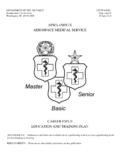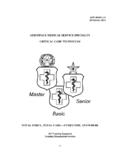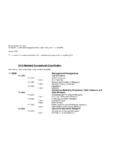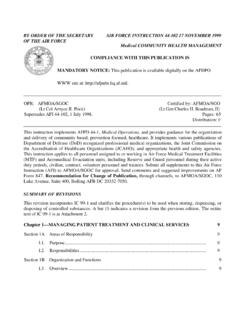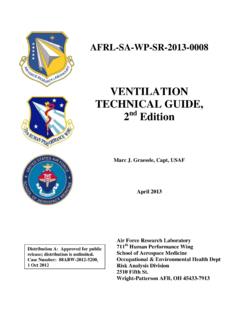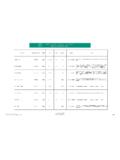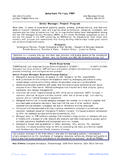Transcription of MEDICAL GUIDELINES FOR AIRLINE TRAVEL - AsMA
1 MEDICAL GUIDELINES FORAIRLINE TRAVEL2ndEditionAerospace MEDICAL AssociationMedical GUIDELINES Task ForceAlexandria, VAVOLUME 74 NUMBER 5 Section II, SupplementMAY 2003 MEDICAL GUIDELINES for AIRLINE TRAVEL ,2ndEditionA1 IntroductionA1 Stresses of FlightA2 MEDICAL Evaluation and AIRLINE Special ServicesA2 MEDICAL EvaluationA2 AIRLINE Special ServicesA3 Inflight MEDICAL CareA4 Reported Inflight Illness and DeathA4 Immunization and Malaria ProphylaxisA5 Basic ImmunizationsA5 Supplemental ImmunizationsA5 Malaria ProphylaxisA6 Cardiovascular DiseaseA7 Deep Venous ThrombosisA8 Pulmonary DiseaseA10 Pregnancy and Air TravelA10 Maternal and Fetal ConsiderationsA11 TRAVEL and ChildrenA11 Ear, Nose.
2 And ThroatA11 EarA11 Nose and sinusesA12 ThroatA12 Surgical ConditionsA13 NeuropsychiatryA13 NeurologicalA13 PsychiatricA14 Miscellaneous ConditionsB14 Air SicknessB14 AnemiaA14 Decompression IllnessA15 DiabetesA16 Jet LagA17 DiarrheaA17 FracturesA18 Ophthalmological ConditionsA18 RadiationA18 ReferencesCopyright 2003 by the aerospace MEDICAL Association, 320 S. Henry St., Alexandria, VA 22314-3579 The paper used in this publication meets the minimum requirements of American National Standardfor Information Sciences Permanence of Paper for Printed Library Materials. ANSI GUIDELINES for AIRLINE TRAVEL , 2nd MEDICAL Association, MEDICAL GuidelinesTask Force, Alexandria, VAIntroductionEach year approximately 1 billion people TRAVEL by airon the many domestic and international airlines .
3 It hasbeen predicted that in the coming two decades, thenumber of passengers will double. A global increase intravel, as well as an increasingly aged population inmany countries, makes it reasonable to assume thatthere will be a significant increase in older passengersand passengers with illness. Patients frequently asktheir physicians whether or not it is advisable for themto TRAVEL , and if so, what precautions they should , physicians need to be aware of the envi-ronmental and physiological stresses of flight in orderto properly advise their patients. In addition, becauseinternational travelers can fly to the four corners of theworld in just hours, a basic understanding of vaccina-tions is caveats are brought to the attention of thereader.
4 First, if inflight illness or even death has occa-sionally been reported by the airlines , the event was notnecessarily caused by AIRLINE TRAVEL or the stresses offlight. The physician must be mindful that, with somany passengers spending so many hours inflight, fly-ing and the MEDICAL event may be coincidental ratherthan causal. Second, the GUIDELINES described herein arejust that GUIDELINES , and not rigid criteria or hard andfast rules. Like all patient management, these guidelinesmust be individualized and tempered by the physi-cian s clinical publication was prepared by the AerospaceMedical Association MEDICAL GUIDELINES Task information contained herein is for primary careand specialist physicians so they will be better preparedto advise patients who are contemplating air TRAVEL .
5 (The reader is cautioned that the material applies onlyto passengers and not to AIRLINE crews or cabin atten-dants.) The authors sincerely hope that this publicationwill educate the physician and contribute to safe andcomfortable flight for of FlightModern commercial aircraft are very safe and, inmost cases, reasonably comfortable. However, allflights, short or long haul, impose stresses on all pas-sengers. Preflight stresses include airport tumult on theground such as carrying baggage, walking long dis-tances, and being delayed. Inflight stresses include low-ered barometric pressure and partial pressure of oxy-gen, noise, vibration (including turbulence), cigarettesmoke, uncomfortable temperatures and low humidity,jet lag, and cramped seating (64).
6 Nevertheless, healthypassengers endure these stresses which, for the mostpart, are quickly forgotten once the destination isreached. In general, passengers with illness ( , stableillness) also usually depart the destination airport nonethe worse. However, there is always the potential forsuch passengers to become ill during or after the flightdue to these primary difference between the aircraft environ-ment and the ground environment relates to the atmo-sphere. Contrary to popular belief, modern aircraft arenot pressurized to sea level equivalent. Instead, on mostflights the cabin altitude will be between 5000 and 8000ft (1524 m and 2438 m).
7 This results in reduced baro-metric pressure with a concomitant decrease in partialpressure of oxygen (PO2). While the barometric pressureis 760 mm Hg at sea level with a corresponding PaO2(arterial O2pressure) of 98 mm Hg, the barometricpressure at 8000 ft will be 565 mm Hg with PaO2of about55 mm Hg. If these last data are plotted on the oxyhe-moglobin dissociation curve, we obtain a blood oxygensaturation of 90%. Although most healthy travelers cannormally compensate for this amount of hypoxemia,this may not be true for coronary, pulmonary, cerebro-vascular, and anemic patients. Because these patientsmay already have a reduced PaO2on the ground, furtherreduction in aircraft cabin pressure will bring them tothe steep part of the oxyhemoglobin dissociation curvewith a resultant very low saturation, which could causedistress and/or exacerbation of their illness (Fig.)
8 1).The hazards of cigarette smoking, active and passive,are well known and need not be recounted here. Thereis a worldwide movement to ban inflight smoking, withthe International Civil Aviation Organization (ICAO)having asked all member States to comply. aircarriers prohibit smoking on all flights. As a result,there has been vast improvement in cabin air qualityand commensurate crew and passenger comfort. (Forpassengers with the potential for inflight nicotine with-drawal symptoms, nicotine gum or patch might beconsidered.)Today s aircraft have very low cabin humidity, usu-ally ranging from 10-20%.
9 This is unavoidable becausethe air at high altitude is practically devoid of a result, there can be a drying effect of airwaypassages, the cornea (particularly under contact lenses),and the lag or circadian desynchronosis results from thedesynchronization of the body clock with surroundingA1 Aviation, Space, and Environmental Medicine Vol. 74, No. 5, Section II May 2003environmental cues. It may not only be an annoyancefor healthy passengers, but it can also complicate thetiming of medications, such as insulin (See Jet Lag andDiabetes sections).On commercialflights, regardless of aircraft type,many passengers sit in small, cramped spaces.
10 This isnot only uncomfortable, but also reduces the opportu-nity to get up, stretch, and walk about the cabin. Sittingfor long periods is tolerable for most passengers, but forsome there is the potential for exacerbating peripheraledema, cramps, and other circulatory problems. Of par-ticular concern are deep venous thrombosis and, evenworse, the potential for pulmonary embolus (See DeepVenous Thrombosis section). MEDICAL Evaluation and AIRLINE Special ServicesMedical EvaluationThe time before a commercial airlineflight (preflight)is the best time to assessfitness of the prospectivepassenger. The private physician should review thepassenger s MEDICAL condition, giving special consider-ation to the dosage and timing of any medications,contagiousness, and the need for special assistance a general rule, an individual with an unstablemedical condition should notfly.
